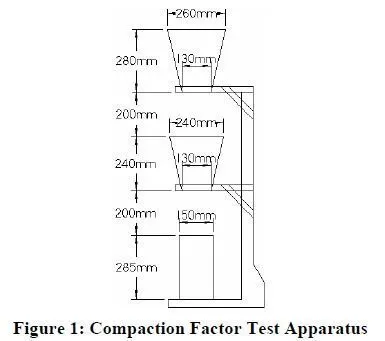The free orifice test (Bartos 1992; Bartos 1994; Wong et al. 2000; Bartos, Sonebi, and Tamimi 2002) measures the time for concrete to flow through a vertical tube and out a smaller diameter orifice at the bottom of the tube. The test was originally developed by Bartos in 1978 as a rapid field test to measure the workability of concretes that were too flowable to be measured with the slump test.
The apparatus consists of a 600 mm long, 100 mm diameter pipe held in a vertical position with a tripod. An interchangeable orifice, which narrows the diameter of the pipe, is attached to the bottom of the pipe. The standard orifice size of 80 mm is appropriate for concrete mixes with a maximum aggregate size of 20 mm. Other typical orifice sizes are 70 mm and 90 mm. To perform the test, concrete is placed in the pipe but not compacted. A door on the bottom of the orifice is opened and the time for the concrete to flow completely out of the pipe is measured.
For normal, flowable concrete mixes, Bartos (1992) reported typical flow times of 1.5 to 6 seconds; however, more cohesive concretes can have flow times greater than 60 seconds. If a mix is highly susceptible to segregation, coarse aggregates tend to accumulate near the orifice and slow or completely block flow. A non-continuous discharge can suggest a concrete
mixtures susceptibility to segregation. The standard test requires approximately 7.5 liters of concrete and should be repeated at least 2-3 times. In some cases, the results of the free orifice test have been correlated to slump (Wong et al. 2000).
The free orifice test is simple and easily portable; however, it requires modifications in order to measure a wider range of concrete mixtures. For concretes with low slump, a vibrator could be attached externally to the pipe in order to promote flow. Different size aggregates require different size orifices, a fact that complicates the comparison of test data. The main source of error is operator error in measuring the exact start and stop times for the test.
Wong et al. (2000) made several recommendations for modifying the free orifice device in order to obtain additional information about the concrete mix. The time for the concrete to flow out ofthe tube could be used in addition to slump in order to characterize workability better.
Alternatively, multiple shear rates could be achieved by placing surcharge weights on the concrete. While this idea of using multiple shear rates has been suggested, it is unknown whether this idea has been attempted.
In a test of anti-washout mixtures conducted by Bartos (1994), the free orifice device clearly showed changes in the cohesiveness of the concrete mixtures. Further, the free orifice test successfully showed sensitivity to changes in fine aggregate content. By contrast, when the flow table test was performed on the same concrete mixtures, the associated changes in workability due to changes in fine aggregate content were not detected.
Advantages:
The test is inexpensive and simple to use. Even if the apparatus is not placed on level ground, an accurate result can still be obtained.
The test quickly provides a direct result.
The test represents a good simulation of actual placing conditions for highly flowable concretes.
Disadvantages:
The test method is only appropriate for highly flowable and self-compacting concretes.
Although the test provides a good indication of cohesiveness, the results are not
expressed in terms of fundamental units.
